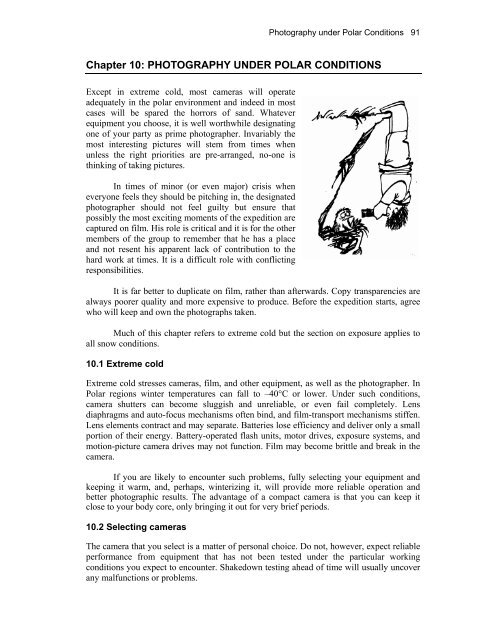Edited by Rachel Duncan 4th Edition ISBN 0-907649-91-2 London ...
Edited by Rachel Duncan 4th Edition ISBN 0-907649-91-2 London ...
Edited by Rachel Duncan 4th Edition ISBN 0-907649-91-2 London ...
You also want an ePaper? Increase the reach of your titles
YUMPU automatically turns print PDFs into web optimized ePapers that Google loves.
Photography under Polar Conditions <strong>91</strong><br />
Chapter 10: PHOTOGRAPHY UNDER POLAR CONDITIONS<br />
Except in extreme cold, most cameras will operate<br />
adequately in the polar environment and indeed in most<br />
cases will be spared the horrors of sand. Whatever<br />
equipment you choose, it is well worthwhile designating<br />
one of your party as prime photographer. Invariably the<br />
most interesting pictures will stem from times when<br />
unless the right priorities are pre-arranged, no-one is<br />
thinking of taking pictures.<br />
In times of minor (or even major) crisis when<br />
everyone feels they should be pitching in, the designated<br />
photographer should not feel guilty but ensure that<br />
possibly the most exciting moments of the expedition are<br />
captured on film. His role is critical and it is for the other<br />
members of the group to remember that he has a place<br />
and not resent his apparent lack of contribution to the<br />
hard work at times. It is a difficult role with conflicting<br />
responsibilities.<br />
It is far better to duplicate on film, rather than afterwards. Copy transparencies are<br />
always poorer quality and more expensive to produce. Before the expedition starts, agree<br />
who will keep and own the photographs taken.<br />
Much of this chapter refers to extreme cold but the section on exposure applies to<br />
all snow conditions.<br />
10.1 Extreme cold<br />
Extreme cold stresses cameras, film, and other equipment, as well as the photographer. In<br />
Polar regions winter temperatures can fall to –40°C or lower. Under such conditions,<br />
camera shutters can become sluggish and unreliable, or even fail completely. Lens<br />
diaphragms and auto-focus mechanisms often bind, and film-transport mechanisms stiffen.<br />
Lens elements contract and may separate. Batteries lose efficiency and deliver only a small<br />
portion of their energy. Battery-operated flash units, motor drives, exposure systems, and<br />
motion-picture camera drives may not function. Film may become brittle and break in the<br />
camera.<br />
If you are likely to encounter such problems, fully selecting your equipment and<br />
keeping it warm, and, perhaps, winterizing it, will provide more reliable operation and<br />
better photographic results. The advantage of a compact camera is that you can keep it<br />
close to your body core, only bringing it out for very brief periods.<br />
10.2 Selecting cameras<br />
The camera that you select is a matter of personal choice. Do not, however, expect reliable<br />
performance from equipment that has not been tested under the particular working<br />
conditions you expect to encounter. Shakedown testing ahead of time will usually uncover<br />
any malfunctions or problems.

















